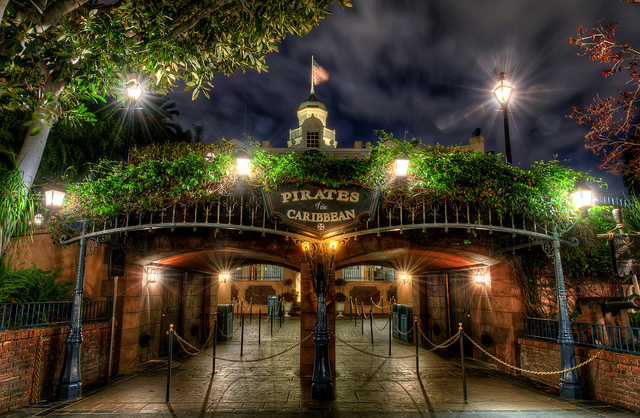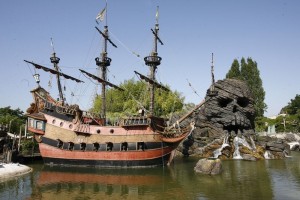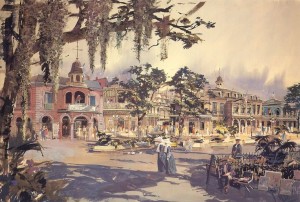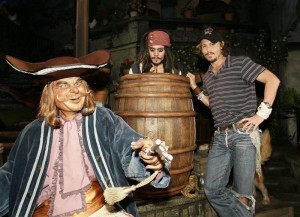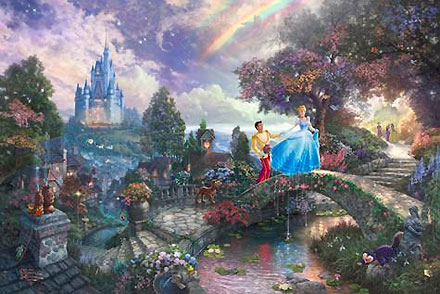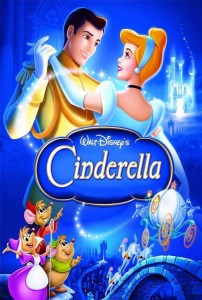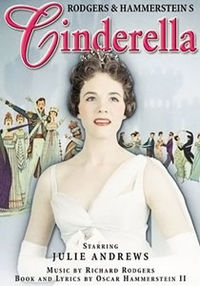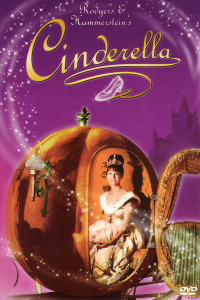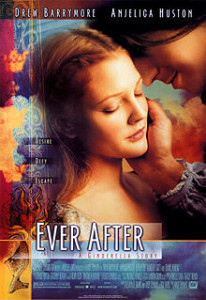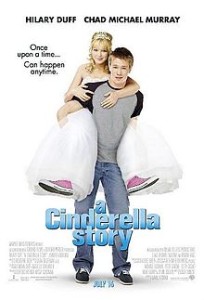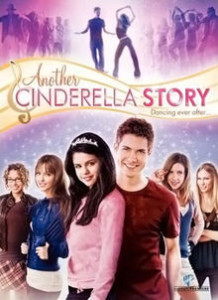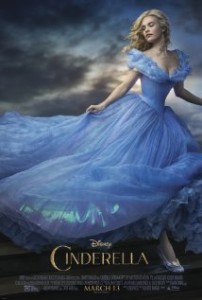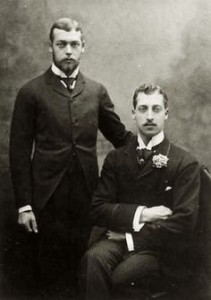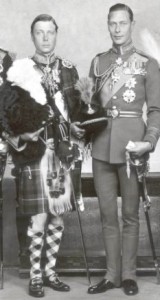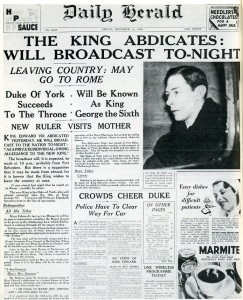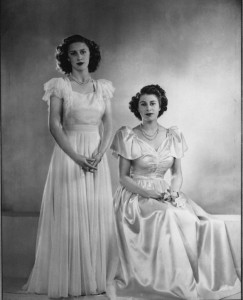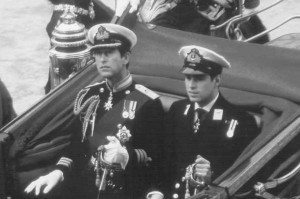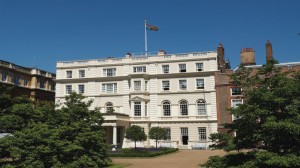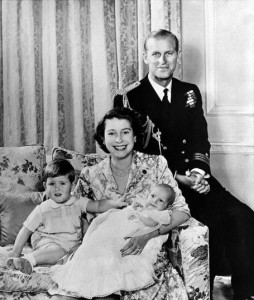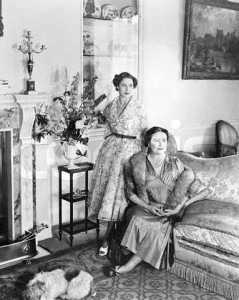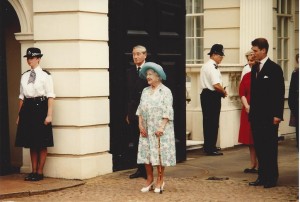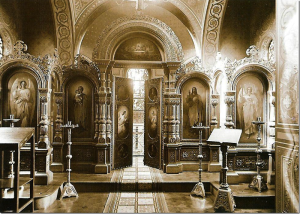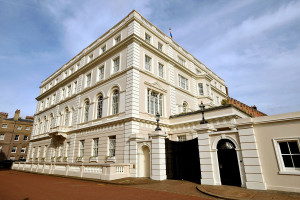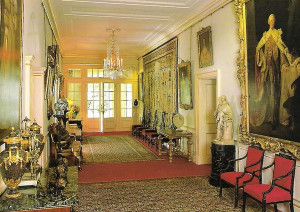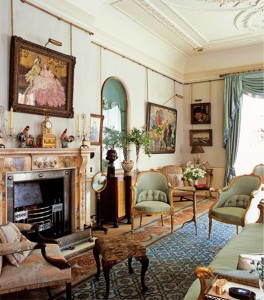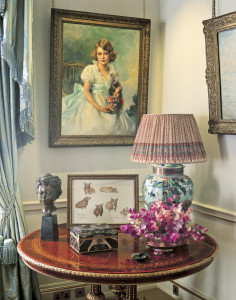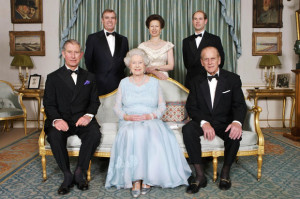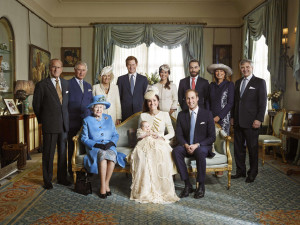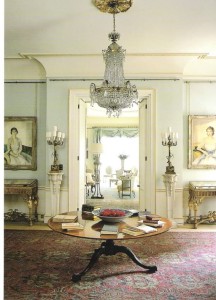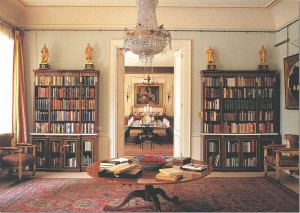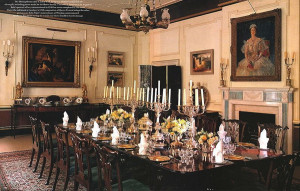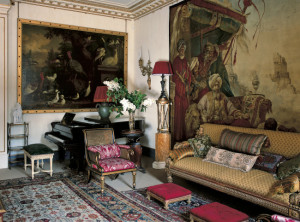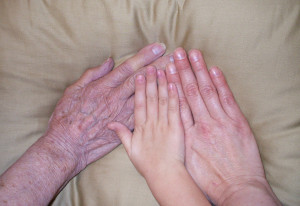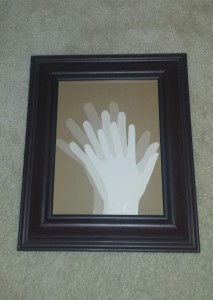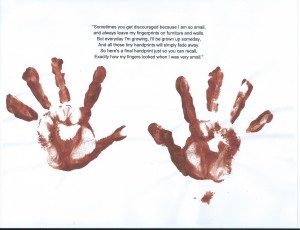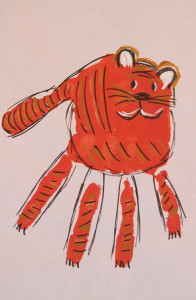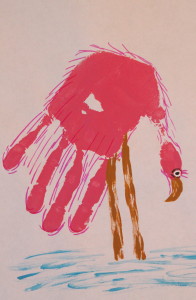Our family has been enjoying Disneyland for almost sixty years and we have so many memories of spending wonderful times at the park. One of the first things we do on a visit is head over to New Orleans Square to ride one of the most popular rides in the park … Pirates of the Caribbean. We also enjoy eating at the Blue Bayou which is the restaurant located within the ride and is famous for its Monte Cristo Sandwich. In this post I will discuss the history of the Disneyland attraction, the many changes to the ride over the years and some fun Pirates of the Caribbean trivia.
The history of the Pirates of the Caribbean ride at Disneyland
The idea for a pirate themed attraction dates back to the early 1950s, when Disneyland was being planned, and there was a ride concept for a walk-through wax museum featuring scenes with famous pirates for history, but that idea was put on hold and never built. Instead, at the time that Disneyland opened Anaheim, CA in 1955, there was a Pirate themed attraction located in Fantasyland and it was Captain Hook’s Pirate Ship Restaurant sponsored by Chicken of the Sea and later in 1960 Skull Rock from the 1953 Disney animated movie “Peter Pan” was added. Both attractions remained at Disneyland for several years until the 1982 refurbishment of the New Fantasyland, the Dumbo attraction now stands where the former Captain Hook’s Pirate Ship and Skull Rock where originally located. (Currently, Captain Hook’s Pirate Ship Restaurant and Skull Rock can be seen again in Adventureland at Disneyland Paris in France)
By this time, the Disney Company had a separate division that was responsible for the creation and construction of the Disney theme park; it was originally known as WED which are the initials of Walter Elias Disney. The staff of visual artists and engineers was collectively known as imagineers, a name meaning employees that combined imagination and engineering to design and build rides for the Disney theme park. Several years later, when Walt was considering creating a new “land” called New Orleans Square at Disneyland he decided the time was right to finally create a pirate ride.
When the It’s a Small World attraction was created for the 1964 New York World’s Fair it featured a new ride technology using water propelled boats but more importantly it was very successful in moving a large number of guests through the attraction in a timely manner and this was exactly what Walt needed for the new pirate ride that he envisioned. So, Walt and his imagineers decided to utilize the same boat ride system that would take guests through the ride to see various scenes featuring audio-animatronic pirates. The relatively new technology of audio-animatronics was basically a type of robotics that was able to make figures move in a realistic way, this was accomplished by means of pneumatic and hydraulic valves used inside the figures and controlled by sonic impulses with a vocal track recorded on a magnetic tape. With these two new technologies as the basis for the new ride concept the imagineers quickly moved forward with ideas.
Herb Ryman, the famous Disney artist that created the original drawings for Disneyland, drew some preliminary sketches that would eventually determine the overall design of New Orleans Square, another Disney artist named Sam McKim also helped with creating the final designs. The new pirate ride would be located in one of the buildings in New Orleans Square and this determined the amount of space allowed for the Pirates of the Caribbean attraction. Marc Davis, a former Disney animator, was now working as an imagineer for WED and he is responsible for the overall interior design of the ride and created numerous sketches, drawings and paintings depicting the various scenes of the pirates attacking, raiding and eventually setting fire to a village. The next step in the process of creating the ride was for the imagineers to utilize storyboards to create a cohesive storyline as guests would move from one scene to another scene; this same technique of storyboards was used frequently by the Disney Studios when plotting out their animated movies. The storyboards of the pirate ride were constantly being revised as scenes were added, changed or eliminated. Once the storyboards were finalized, the next step was to create working small-scale models of the various scenes which would be used for the ride. Using small inexpensive models was a better way to keep building costs down by making changes on the models instead on the more expensive full-sized structures.
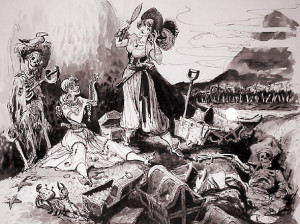
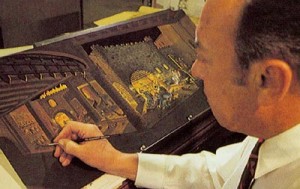
Now that the Pirate of the Caribbean ride designs where finished it was time to build. The new ride would be located in New Orleans Square which was designed with several antebellum-style buildings containing shops and restaurants. The main building where the ride would be located is a multi-level structure with the majority of the ride located under the building and streets of New Orleans Square. The first step in the ride construction was excavating a large area to accommodate the space for the ride’s various village scenes. The next step was laying the guide rails for the pirate boats that would take guests through the ride, eventually the ride would use 750,000 gallons of water to propel the boats and also create the scenic areas of the ride. Two 21-degree drops were required at the beginning of the ride to take guests underground and into the main show building located beyond the berm of the park. At the end of the ride, the boat needed to get back to the ground level and this was achieved by the guests remaining in the boats as a chain pulley system, similar to the technique used to pull a roll coaster uphill, was used to return guests to the loading/unloading area of the ride. (When the Pirates of the Caribbean ride was added to Walt Disney World in Florida, the boat path was revised so that guests unloaded before the ascent)
Please note that some of the photos of the New Orleans Square and Pirates of the Caribbean construction shown below were originally used on the davelandblog.com website.
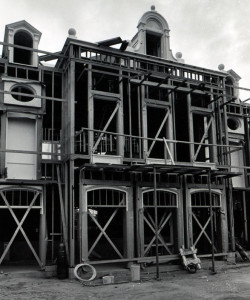
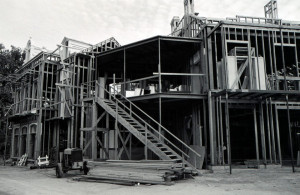

As the building process was going on, imagineer Blaine Gibson was heading up a team to create the pirate figures for the ride. The look of the figures changed from fierce looking pirates to more whimsical ones to be used in some of the more humorous scenes of the ride. Before the figures could be added, the various ride scenes needed to be constructed. These scenes ranged from the quiet bayou scene located after the guest load area and before the two drops, to the dark and mysterious caverns after plunging down the waterfall, to the misty scene where the pirates attack the village, to the numerous scenes of the pirates pillaging the village just before the ride comes to a fiery end.
Then in 1966, as the ride was nearing completion, Walt Disney suddenly died. Walt’s health had severely deteriorated after years of smoking. Always concerned more for the good of his company then his personal health, Walt kept his condition as quite as possible telling only his family, a few close friends and co-workers that he need to be hospitalize to have one of his lungs removed. The company’s employees and stockholders were told that he was receiving treatment for an old polo injury so as not to effect the daily and long term operation of the Disney Company. Sadly, Walt died on December 15, 1966. After a brief period of mourning the work on the Pirates attraction resumed and was eventually completed three months later with an official opening date of March 18, 1967.
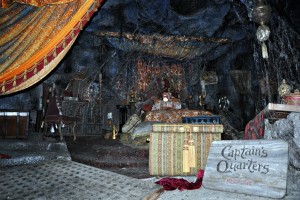
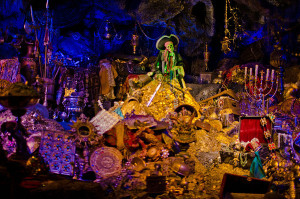
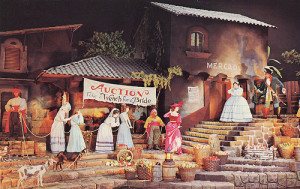
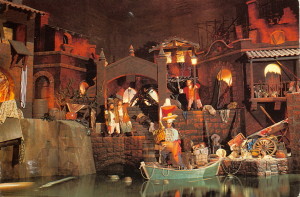

The Pirates of the Caribbean attraction was a success from the day it opened and over the years it has become one of the most popular rides at Disneyland. Later, other versions were built in the Disney theme parks using different facades but always with the interior ride being very similar to the original one. The Magic Kingdom (Walt Disney World) Pirates of the Caribbean ride opened in 1973, Tokyo Disneyland in 1983, Disneyland Paris in 1992 and currently one is under construction at the Shanghai Disneyland with a projected opening date of December 2015.
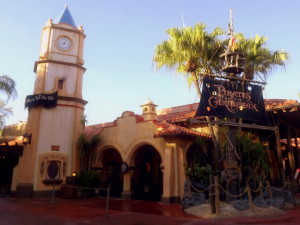
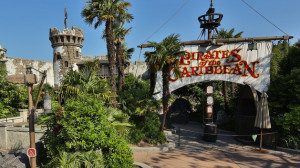
Pirates of the Caribbean ride trivia
- The Pirates of the Caribbean ride was the last Disneyland attraction that was personally supervised by Walt Disney from ride concept and design through to construction, he died three months before the official opening.
- The Pirates of the Caribbean ride cost approximately $8 million dollars to build in Disneyland which is almost equal to the amount paid to France when the United States negotiated the Louisiana Purchase in 1803 which included the city of New Orleans.
- The Disneyland Pirates of the Caribbean ride is contained in two large show buildings covering a total of 112,826 feet. located beyond the berm of the park.
- The ride uses 750,000 gallons of water which flows through the 1,838 feet length of the ride’s canals.
- There are approximately 122 audio animatronic characters (68 pirates and villagers and 54 animals) used on the Pirates of the Caribbean ride
- The façade of the main building to the attraction is said to have been inspired by the architecture of the Cabildo building located in Jackson Square in New Orleans, the building was the site where the Louisiana Purchase was signed in 1803.
- Atop the tall tower of the main building of the Pirates attraction a 31 star United States flag can be seen, this corresponding to the 1850s which is the time period that New Orleans Square is supposed to be set.
- The Laffite Landing sign which hangs over the Pirates of the Caribbean boat load/unload area is for the famous pirate, Jean Lafitte, who fought with the U.S. Army during the War of 1812 at the Battle of New Orleans. (The name is spelled as the pirate originally used it and not the later English version which is how it is written in the history books)
- The Pirate of the Caribbean ride features the memorable song, “Yo-Ho, a Pirates Life for Me”. The music is by George Bruns and the lyrics are by Francis Xavier Atencio. Bruns is best known as the co-writer of another Disney classic, “The Ballad of Davy Crockett”. Atencio wrote the theme song for the Haunted Mansion attraction, “Grim Grinning Ghosts”. Atencio voice can also be heard on the Pirates ride as the Jolly Roger skull and crossbones just before the boat plunges down the first waterfall.
- In the battle scene of the Pirates of the Caribbean ride cannonballs seem to be flying over the guests as they ride through, but it is only a Disney illusion using recorded sounds and flashes of light are used to create the effect that cannon are firing from the pirate ship and also on land from the village fortress. A splash of water gives the effect that the cannonballs are missing their targets and landing in the water, recently puffs of air have been added to create the addition effect of the cannonballs flying past.
- In the village pillaging scenes, the original version of the ride featured several pirates chasing giggling ladies, on was even seen chasing after a pirate! When guests complained about the “sexual implication” of the scene it was altered to reflect a more “chaise” behavior. The ladies now carrying cakes, pastries and other food items that the starving pirates want. An interesting observation is that the bride auction scene remains unchanged.
- Toward the end of the ride, the pirates set fire to the village. The fire effect created by the Disney imagineers was so realistic that prior the attraction’s grand opening the Anaheim Fire Chief almost shut down the ride until he realized that it was only an illusion. (The fire is basically created by pieces of fabric, lights and fans!) The Anaheim Fire Department did request that the ride should be altered so that in the event of a real fire the simulated fire effect would automatically shut off.
- On the upper level of the building of Pirates of the Carribbean building was originally planned for a private apartment for the personal use of the Disney family. Located at the front of the building, slightly to the right side, is where the front veranda for the Disney apartment would have been and there is a wrought iron railing which incorporates the intertwined initials of Walt Disney (WD) and Roy Disney (RD). The Disney apartment which was never fully completed was eventually converted into the Disney Gallery which was a retail store and showroom featuring Disney artwork and collectible items. In 2007, the space was refurbished and reopened as the Disneyland Dream Suite which is the only overnight guest accommodations located within Disneyland.
- In 2003, Disney released the “Pirates of the Caribbean: The Curse of the Black Pearl” movie which was inspired by the original Disneyland ride. Some scenes in the movie featured iconic ride scenes, such as the jail scene with the pirates trying to get the keys from the mouth of the dog. Even the famous “Yo-Ho, A Pirates Life For Me” song was used in the movie. The film’s world premiere was held at Disneyland and featured the longest red carpet in history; it went from Main Street to New Orleans Square. The movie proved to be very successful and additional sequels have been filmed, in fact the fifth installation of the Pirates of the Caribbean series is currently being filmed.
- Following the success of the Pirates of the Caribbean film series, several characters from the movies have been added to the ride. The character of Jack Sparrow, played by Johnny Depp, appears several times in various village scenes and Captain Barbossa, played by Geoffrey Rush, can be seen on the pirate ship as it attacks the village. Additionally, one of the most impressive effects of adding the movie’s character into the ride is when the faces of Davy Jones (from “Dead Man’s Chest” and “At World’s End”) and Blackbeard (from “On Stranger Tides”) were projected onto the mist before the second waterfall drop. Recently mermaids from “On Stranger Tides” have also been added to the ride.

